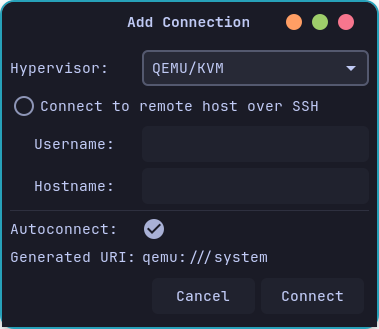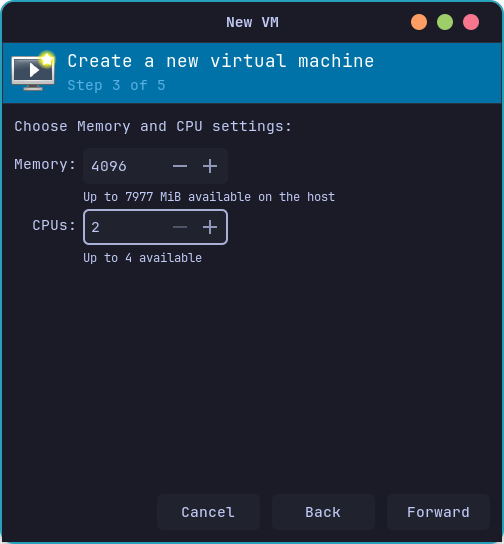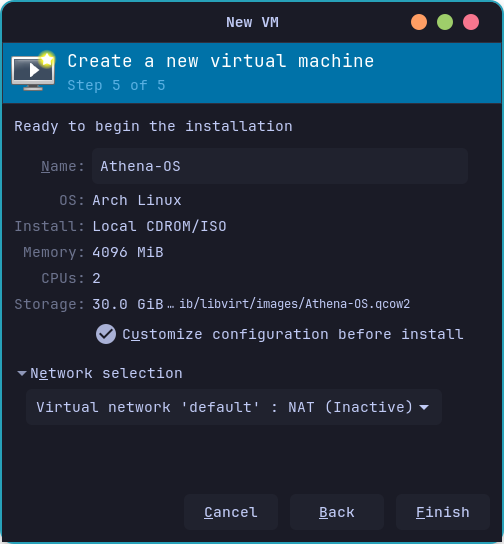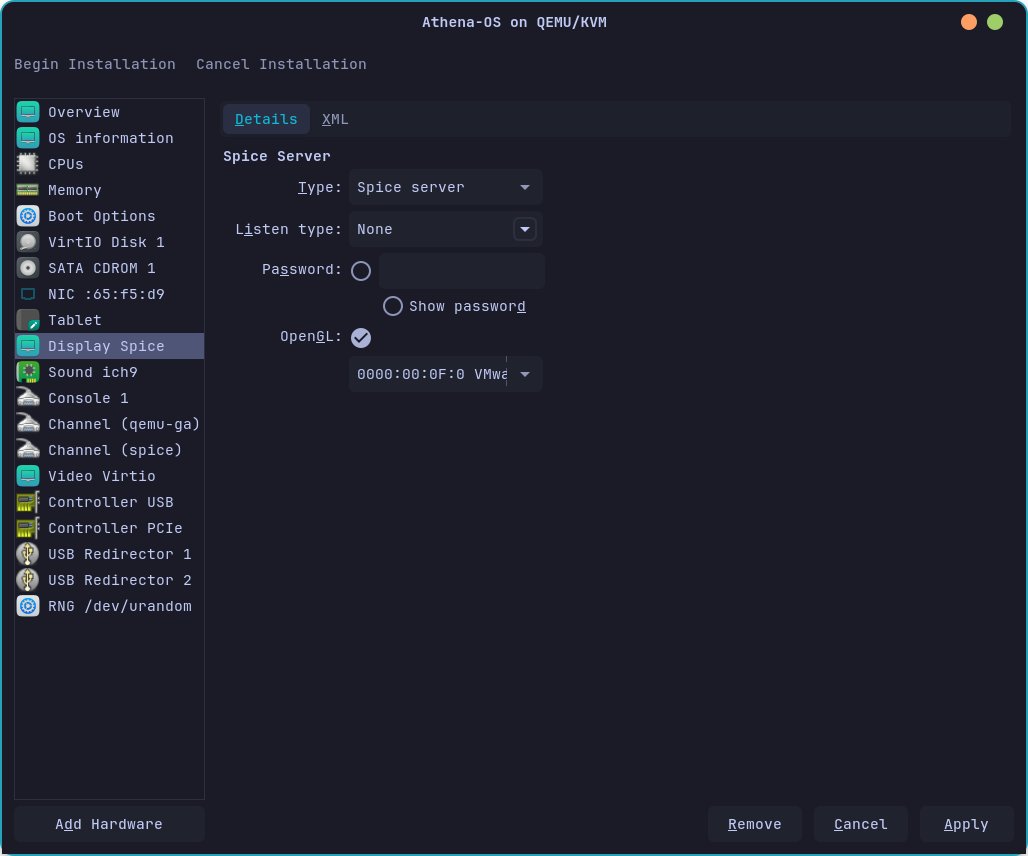Installing as guest in QEMU/KVM
This guide shows you how to run Athena OS inside of QEMU and KVM as hypervisor both for Linux and Windows hosts.
Linux Host - QEMU/KVM with Virt-Manager
Section titled “Linux Host - QEMU/KVM with Virt-Manager”First, you need to prepare your environment for running Virt-Manager (LibVirt GUI client) that will allow you to run Athena OS in QEMU. In an Arch-based Linux environment as host to use Athena OS as guest, install Virt-Manager by:
sudo pacman -S virt-manager qemu-full dnsmasq swtpmsudo systemctl enable --now libvirtdRun virt-manager. At first run, in case there is only LXC connection but not QEMU/KVM connection, click on File -> Add Connection…, be sure that Hypervisor field is set to QEMU/KVM and click on Connect

Once connected, click on QEMU/KVM entry and click on Create a new virtual machine icon button and set the several settings in the following manner

On the next step, click on Browse… and on the popup window click on Browse Local button at bottom side and select the Athena ISO image file

Deselect Automatically detect from the installation media / source checkbox and the current step should appear as

Then, set your resources as CPU and RAM

Set the disk size of the virtual machine

On the final summary window, check Customize configuration before install checkbox, assign a VM name, expand the network selection for checking if it is set on NAT and click on Finish

You could get a message related to the activation of the Virtual Network, press Yes

Afterwards, the VM settings window is opened. On Overview pane, in the Firmware field select UEFI

Then, move to CPUs tab and expand Topology section and increment Sockets and Cores at least to 2

Move to Display Spice tab, set Listen type to None and check OpenGL in order to use it

Finally, make sure that the 3D Acceleration is enabled on Video Virtio tab

Finally, if your computer supports TPM 2.0, click on Add Hardware on bottom-left side, find for TPM and add it according to the following image

At the end, apply all the changes and click on Begin Installation button on the top-left side of the settings window.
When the VM is run, install Athena OS as explained in Installing as baremetal chapter.
Windows Host - QEMU
Section titled “Windows Host - QEMU”For using QEMU on Windows Host, it is important to enable Virtualization by the BIOS and have Hyper-V enabled in order to use WHPX as accelerator.
First, reboot and access to your BIOS, select the Virtualization Technology, Intel Virtual Technology, or SVM Mode option (the feature name will depend on your manufacturer). Enable the virtualization feature. Save configuration and reboot.
After reboot, when landed on Windows, create a file called hyperv-home.bat with the following content:
pushd "%~dp0"dir /b %SystemRoot%\servicing\Packages\*Hyper-V*.mum >hv-home.txtfor /f %%i in ('findstr /i . hv-home.txt 2^>nul') do dism /online /norestart /add-package:"%SystemRoot%\servicing\Packages\%%i"del hv-home.txtDism /online /enable-feature /featurename:Microsoft-Hyper-V -All /LimitAccess /ALLpauseRun it. This script will download and install Hyper-V feature if your Windows does not have it.
Then, by Windows search bar reach Turn Windows features on or off and check for Hyper-V, Virtual Machine Platform and Windows Hypervisor Platform. Click OK and reboot.
Open PowerShell as Administrator and run bcdedit /enum and be sure that hypervisorlaunchtype is set to Auto (that means “ON”). If not, run bcdedit /set hypervisorlaunchtype auto.
Now install QEMU for Windows from the official website. After the installation, go to the Windows search bar and reach Edit the system environment variables. Click on Environment Variables..., go to Path, click on Edit..., click on New and add the QEMU installation path (by default is: C:\Program Files\qemu). Click OK on all opened windows.
Since it could be very useful running our Athena OS by UEFI, we need to retrieve UEFI libraries for allowing QEMU to work in UEFI mode. For doing this, from https://www.kraxel.org/repos/jenkins/edk2/ download the latest version of edk2.git-ovmf-x64-0-20220719.209.gf0064ac3af.EOL.no.nore.updates.noarch.rpm file, then by 7zip, extract the content in a new folder. You will get a .cpio file. Again, by 7zip, extract the content of this .cpio file in a folder. It will contain our .fd file for allowing QEMU to run in UEFI mode. We will use the path to this file in the final QEMU command.
Now it is all set for running Athena OS on QEMU!
Open PowerShell. For first we need to create a disk where we must install Athena OS. Do it by running:
qemu-img create -f qcow2 athena30.img 30G30G is the disk space we would like to assign to the disk. athena30.img will be created in the current directory but if you wish, you can type the entire path you would like to store it.
Now, we can run Athena OS by QEMU:
qemu-system-x86_64.exe -boot order=dc -hda .\athena30.img -cdrom .\VirtualShare\athena-2023.01.23-x86_64.iso -m 4G -accel whpx,kernel-irqchip=off -smp 2 -device VGA -device qemu-xhci -bios C:\Users\<USERNAME>\Downloads\edk2.git-ovmf-x64-0-20220719.209.gf0064ac3af.EOL.no.nore.updates.noarch\usr\share\edk2.git\ovmf-x64\OVMF_CODE-pure-efi.fd -cpu Nehalem -chardev socket,id=qga0,server=on,wait=off -device virtio-serial-pci,id=virtio-serial0 -device virtserialport,bus=virtio-serial0.0,nr=1,chardev=qga0,id=channel0,name=org.qemu.guest_agent.0By this command, QEMU will boot the Athena OS ISO that we use for installing Athena OS as explained in Installing as baremetal chapter.
After the installation, turn off the virtual machine and, for booting directly to the Athena OS disk, just remove -cdrom <path-to-iso> argument. The final QEMU command to call should be:
qemu-system-x86_64.exe -boot order=c -hda .\athena30.img -m 4G -accel whpx,kernel-irqchip=off -smp 2 -device VGA -device qemu-xhci -bios 'C:\Users\Username\Downloads\edk2.git-ovmf-x64-0-20220719.209.gf0064ac3af.EOL.no.nore.updates.noarch\usr\share\edk2.git\ovmf-x64\OVMF_CODE-pure-efi.fd' -cpu Nehalem -chardev socket,id=qga0,server=on,wait=off -device virtio-serial-pci,id=virtio-serial0 -device virtserialport,bus=virtio-serial0.0,nr=1,chardev=qga0,id=channel0,name=org.qemu.guest_agent.0The command above enables the virtual machine to use QEMU Guest Agent. In general, a Linux distro that would like to use it, need to install qemu-guest-agent package, then run sudo systemctl restart qemu-guest-agent. At the end, just verify it is active by running sudo systemctl status qemu-guest-agent.
QEMU Parameters
Section titled “QEMU Parameters”| Parameter | Description |
|---|---|
-boot order=dc | Set the boot order. d refers to the -cdrom entry and c to the -hda entry. |
-hda <path-to-img> | Specify the disk to boot. |
-cdrom <path-to-iso> | Specify the ISO to boot. |
-m <size> | Set the RAM size. |
-accel <accelerator> | Specify the accelerator to use. |
-smp <core-number> | Set the number of cores to use. |
-bios <path-to-bios-mode-file> | Specify the BIOS mode to use (i.e., UEFI). |
-cpu <CPU type> | Set the CPU type to use. |
-chardev socket,id=qga0,server=on,wait=off -device virtio-serial-pci,id=virtio-serial0 -device virtserialport,bus=virtio-serial0.0,nr=1,chardev=qga0,id=channel0,name=org.qemu.guest_agent.0 | Enable the usage of QEMU Guest Agent. |
Limitations
Section titled “Limitations”The main disadvantage of using QEMU on a Windows host does not allow to perform a GPU Passthrough, it means that all virtual machines running there will work by Software Rendering as graphics. Furthermore, currently it is not clear how to enable 3D Acceleration.